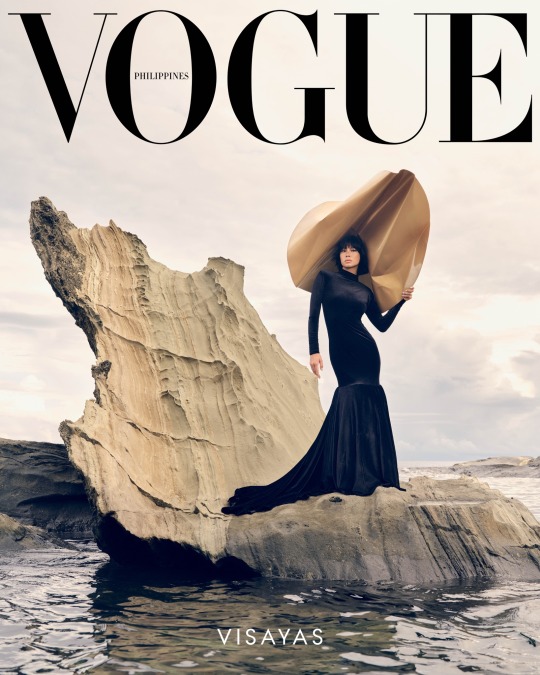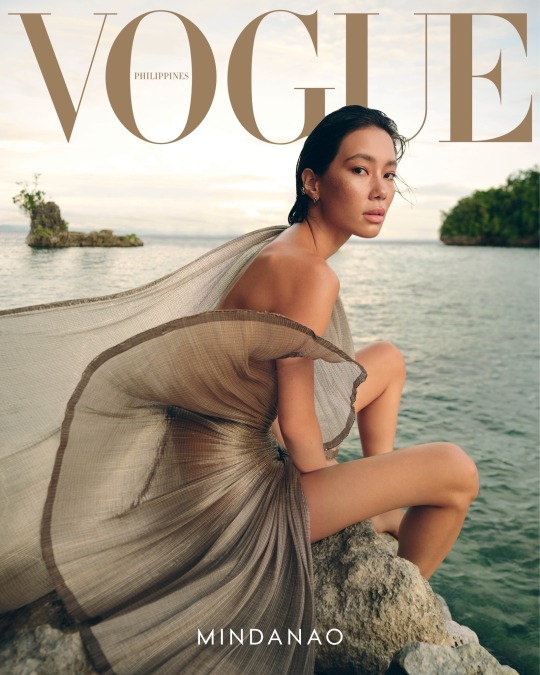#philippine culture
Text
Gubat Banwa is FULLY FUNDED!
In less than A DAY, we've hit our goal of $40,000!
Thank you all so much! Your continued support made this massive achievement for SEA representation in TTRPGs possible. 🔥🔥
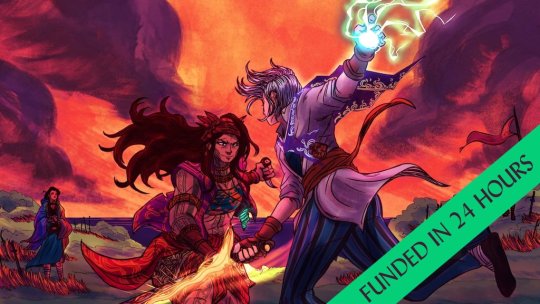
Revel in glory, Kadungganan! This victory belongs to us all!
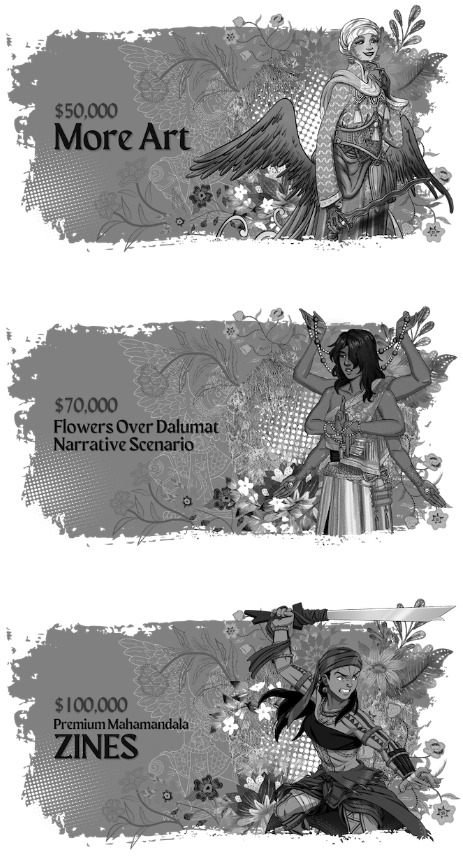
The campaign will continue to run for the next 29 days.
There are a few stretch goals still waiting up ahead, so if any of these catch your interest, do continue to spread the word about the project.
The Gubat Banwa Kickstarter was fully funded in 1 day! (But we've still got some neat surprises in the stretch goals...) Check them out here:
We cannot overstate how deeply we appreciate your support, it truly means the world to this small team from the Philippines.
Now, let us see this campaign through to the end of the far horizons, shields abreast and blades gleaming and heads held high with pride.
Until glory!
#gubat banwa#ttrpg#indie ttrpg#tabletop rpgs#rpg#southeast asia#southeastasia#dnd#kickstarter#philippine blade#weapon design#philippine history#philippine culture#filipino artists#fantasy#fantasy worldbuilding#fully funded#thank you for your continued support!
168 notes
·
View notes
Text
Painting a picture of the history of Filipino Tattoos
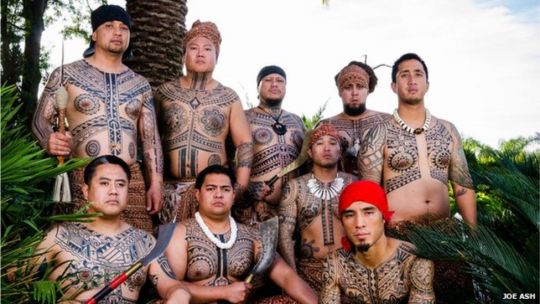
A photo of tattooed Filipino men posted on BBC and accredited to Joe Ash
Tattoos are often seen as integral cultural symbols in my different societies whether it be seen as something honorable or dishonorable. Even in the most straight-laced cultures, a tattoo acts as a mark of some form of the person's history and their standing in their communities as well as how people perceive them.
In a lot of modern cultures, the tattoo often have negative connotations, often associated with delinquency or criminal activity. Historically, however, they may have grander and more honorable significance in different societies. The communities that had existed in the Philippines prior to contact with Spain fits this similar pattern.
Before I start
As usual, the Philippines is a diverse country that has different traditions and histories that come from different ethnic groups and states, only being first unified under a government by colonization. Because of this, this post will only be able to cover parts of this culture and may not be able to fully encompass all Filipino traditions, practices, and beliefs about tattoos.
This is also given the fact that more specific information may be harder to come across or may not exist at all in a space I could easily access.
That being said, the general term for Filipino traditional (both precolonial and current) tattoo practices is batok, batik, patik, or patek depending on language or culture. It is also known as buri or burik in several other groups and languages. This word, however, isn't often used for typical tattooing in most modern communities.
The History
From a general understanding of a lot of precolonial Southeast Asian cultures, it can be assumed that precolonial Filipino societies heavily valued tattoos as their neighboring maritime SEAsian countries also had prior to the introduction of Abrahamic religions to the region which often discouraged or even forbade tattooing the skin.
Although this can be assumed, there were no known precolonial description nor record of these tattoos during the actual time period before Spanish contact. There is evidence found in some burial sites however, as discussed by social anthropologist Salvador-Amores in her paper The Recontextualization of Burik (Traditional Tattoos) of Kabayan Mummies in Benguet to Contemporary Practice (2012). In the paper, she focuses a section on the history of burik by explaining the Kabayan Mummies or the Fire Mummies of Benguet, Mountain Province.
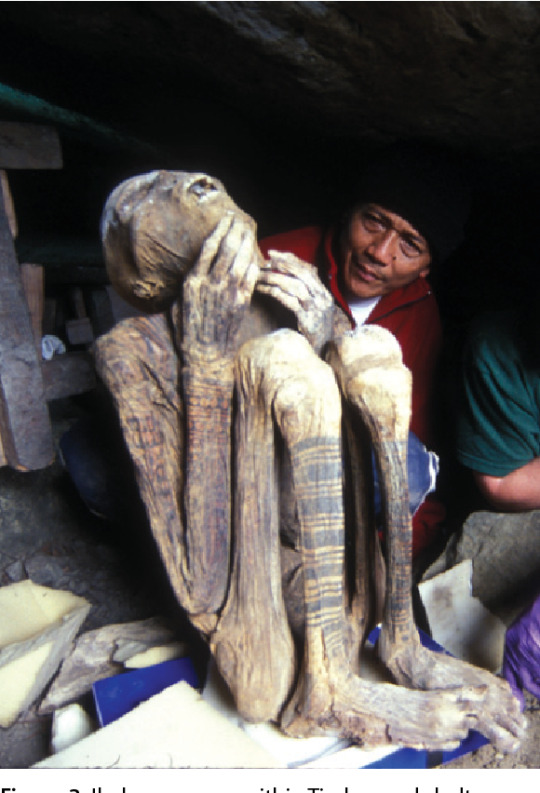
An image of one of the Kabayan Mummies uploaded by Dario Piombino-Miscali on ResearchGate.net
These remains had been dated back to the 13th century and are associated with the Ibaloi, an indigenous ethnic group from Mountain Province found in the northern parts of the island of Luzon. This does confirm that tattooing had been important to the people who had lived in this area during this time period as, in Salvador-Amores's paper, it can be noted that the tattooed mummies seem to be prominent with the adults.
I do have to note that the Ibaloi people, who are part of the larger Igorot ethnic group, were not fully colonized by the Spaniards and therefore does not share the similar Hispanic culture and history that a lot of Filipino groups have. They had only fully been integrated into the Philippines during the American colonial period where they and the other Igorots had been properly colonized by American and placed under the rule of the American-controlled Filipino government. (x)
Regardless, this does show that at least some cultures in the archipelago held tattoos with high importance and did not consider them as something negative compared to the modern perception of tattoos.
The first known illustration of tattooed Filipinos, however, was first seen in the Boxer Codex (circa 1590) during the early Spanish colonial period, written and illustrated by an unknown author.
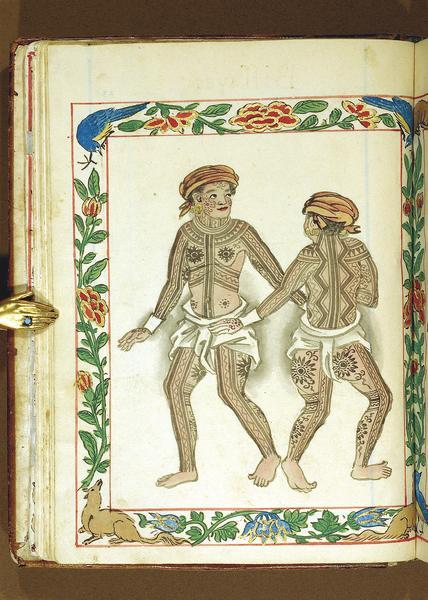
A page from the Boxer Codex (circa 1590), author uknown
This illustration seems to be that of the specific ethnolinguistic group, the Visayans as this page is next to another one labeled as "Biſſaya", a likely earlier spelling of Bisaya that uses the long s (ſ). This aligns with the description given as early as Antonio Pigaffatta, Ferdinand Magellan's chronicler, who consistently describes the Visayans that he has met as painted in his account of their arrival in the islands back in 1521.
The book The Philippine Islands 1493-1898 Vol. XII has compiled different first-hand and second-hand sources about the Philippines during the 15th through 19th century, with Vol. XII focusing on the early 17th century which aligns closely to the Boxer Codex. Within the text, there are several mentions of the "Pintados" or the Painted ones, even having an entire province be called the "province of Pintados".
It isn't made clear who the Pintados are besides the fact that they seem to be hostile towards the Spanish colonizers and had often fought battles with one of the letters even claiming that they had poisoned one of the Spaniards. It isn't until we reach the last part of the compilation which features Pedro Chirino's Relacion de las Yslas Filipinas which I had a hard time finding before but had now found a free and accessible copy. Within Chirino's writing, he explains that the Pintados seem to be a name given by the Spaniards to the Bisayans and further explains it as such:
"The people of the Bisayas are called the Pintados, because they are actually adorned with pictures --not because this is natural to them, although they are well built, of pleasing countenance, and white; but because they adorn their bodies with figures from head to foot, when they are young and have sufficient strength and energy to suffer the torment of the tattooing; and formerly they tattooed themselves when they had performed some act of valor."
Chirino even gives an explanation as to how precolonial Visayans tattooed their skin:
They tattoo themselves by pricking the skin until the blood comes, with sharp, delicate points, according to designs and lines which are first drawn by those who practice this art; and upon this freshly-bleeding surface they apply a black powder, which is never effaced. They do not tattoo the body all at the same time, but by degrees, so that the process often lasts a long time; in ancient times, for each part which was to be tattooed the person must perform some new act of bravery or valiant deed
It is notable, however, that not only did the Spanish not mention any tattoos on other Filipino groups such as the Tagalogs, but a lot of the illustrations in the Boxer Codex do not sport any tattoos at all which makes it confusing as to when had tattoos faded out of cultural significance in these other communities, likely even before Spanish contact.
Lane Wilcken, a researcher who studies the history of tattoos from the Philippines and the Pacific Islands, writes in his book Filipino Tattoos: Ancient to Modern (2010) that it may be possible that the Tagalogs may had lost their tattooing traditions shortly before Spanish contact during the recent islamization of their communities circa 1500 which was and specifically in the polity of Maynila. This may also be the case for the Moros which is a muslim ethnolinguistic group found in the island of Mindanao.
Either way. tattoos became more scarce within Filipino records after the arrival of the Spanish and the introduction of Christianity to the islands, save for some indigenous groups that were not fully colonized by Span like previously mentioned Igorot people.
Because of the spread and dominance of Christian and Islamic customs throughout the country, Batok, as it originally was, was lost to time with the lack of existing artists and cultural relevance tattoos. Tattoos didn't come back to the Filipino mainstream until modern tattoos became more prevalent especially in the mid to late 20th century, similar to its rise in popularity in Western cultures, and even then, it wasn't really what I would consider any traditional and is often negative.
Present Day
Like a lot of other countries, however, tattoos had seen a swing of opinion and is more accepted now as an art form rather than a sign of criminal activity but some stereotypes are still popular.
For instance, during the COVID-19 lockdown, the Department of Education provided modules for students to answer at home which would be then collected by the school from door to door. In one of these modules, Lea Salonga, a Filipino singer, complained on November 17, 2020 on her Facebook page of a discriminatory question that was found in one of the modules, pictured below
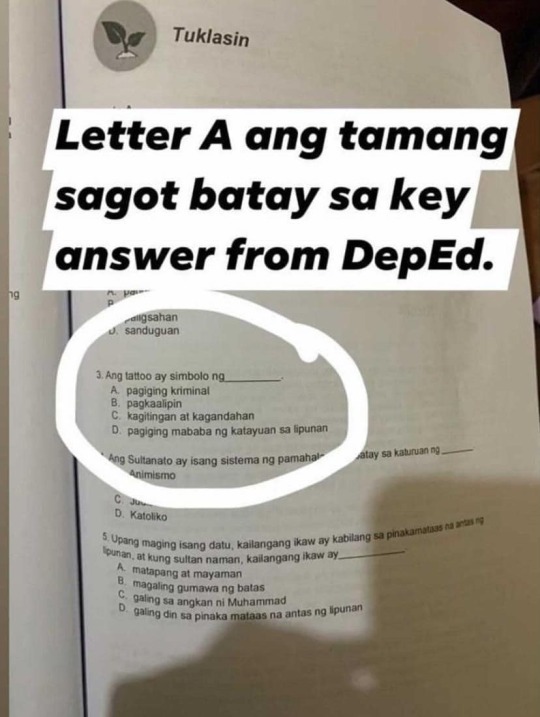
EN Translation:
White text: The answer is letter A based on the DepEd answer key.
Module text:
3. Tattoos are a symbol of _____
A. being a criminal
B. being a slave
C. courage and beauty
D. having a low standing in society
This controversy caused an uproar online and showed that there are a lot of Filipinos today that don't see a problem with tattoos and even see them as a positive. Two days after the image was posted on Salonga's page, the Department of Education publicly recognized the misstep and had issued that they officially recognized the controversial answer as an error.
It is important for me to note that, just like in a lot of countries, tattoos are typically not accepted in the corporate world and those who have them either have to get them removed or at least cover them up if they get hired at all. There's still a common idea that people with tattoos, if not dangerous, may be seen as unprofessional or even unclean which I do know is a similar thing that other countries may have as well.
As for batok, its comeback in the larger Filipino mainstream didn't return until some time in the late 2000s and 2010s when more international influence had resparked and interest in more ethnic cultures including the precolonial Filipino tattoos specifically because of the internet and the rise of social media. The current batok that we see outside of indigenous communities could be seen as a recreation of the extinct practices within the Philippines with some level of appropriation from related cultures (by appropriation, I mean this in a neutral way not a negative one).
It is argued whether or not the reconstructed practice could be considered traditional at all, but considering its heavy emphasis on the older designs found in historical illustrations as well as designs from indigenous communities that did not have practice eradicated by colonization, some also argue that the modern tattoos that has gained prominence because of modern technology and research is still valuable in a socio-anthropological sense.
As Salvado-Amore puts it
the successive phases and changes in the status of burik tattoos—enabled by the advent of modern technology, the Internet, and mass media—encourage an interaction between contemporary and historical influences rather than an extinction of past practice.
About Apo Whang-Od
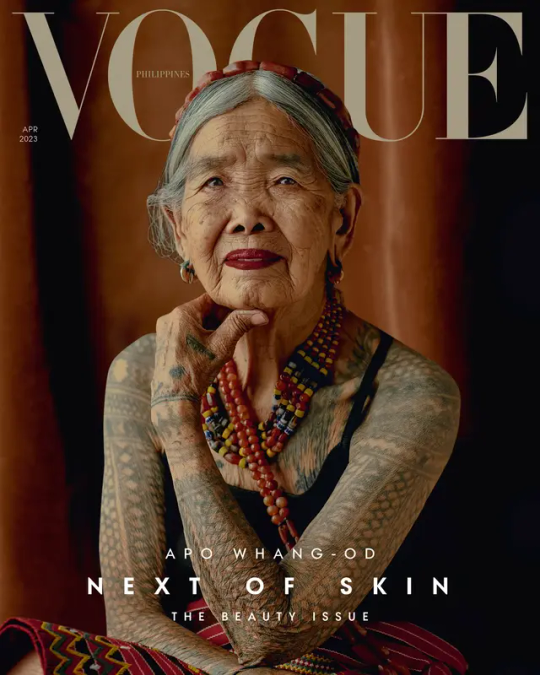
A magazine cover of Vogue featuring Whang-Od, a traditional tattoo artist from the Butbut people, a subgroup within the Kalinga ethnic group. (The rest of this section pulls from the same article by Vogue)
Any research about Filipino tattoos, especially in the modern day would be incomplete without any mention of Whang-Od, the most popular traditional tattoo artist from the Philippines.
Apo Whang-Od (b. February 17, 1917, a.k.a. Maria Oggay) is a member of the Butbut people of the Kalinga indigenous ethnic group from Kalinga province, Philippines. She is often known as one of the last mambabatok in the country which earned her fame and recognition internationally. She started her tattooing practice since she was a teenager at age 16, under the mentorship of her father and was the only known female mambabatok during her time.
For years, she was called on by different communities within her locale in order to tattoo important and symbolic tattoos on members of her and different communities after they had received certain milestones. Men were tattooed for different reasons than women as men were given their marks when they succeed in activities like headhunting, which was ritualistically important for the Butbut people while women were tattooed for reasons like fertility or beauty.
Because of American colonization, however, headhunting was prohibited so she was mostly tattooing women from then onward.
She started gaining recognition some time in the mid-2000s to the 2010s after she started serving foreign tourists, although she doesn't give them the more traditional symbols. Non-members of the group are given a set of tattoos that she could tattoo on anyone without any strong connection to the original meaning of the art.
Since tattooing was passed through family and Whang-Od herself didn't had any children, she was known as the last mambabatok for a time which caused concern for the extinction of the practice as she was already in her 90s when she gained notoriety, but she has since started training her grandniece Grace Palicas and later on her other grandniece Elyang Wigan and the two, who are now in their 20s, has since helped their great aunt dealing with their clientele.
Due to her fame, she is often the subject of foreign media and interest, even being invited by Vogue magazine to pose for one of their covers (pictured above) and is now known as the oldest Vogue cover model earlier this year at the age of 106.
Despite her fame and arguably cultural importance to not only the Kalinga people but the Philippines as well as online petitions since the 2010s to give her the recognition, she is not eligible to receive the National Artist award— one of the highest awards given to artists of most artistic fields of which only 81 people had received. Victorino Manalo, Chairman of the National Commission for Culture and Arts (NCCA) explains that this is because her craft, tattooing, isn't covered by the NCCA but by the Gawad sa Manlilikha ng Bayan (GAMBA, en. Award for Crafters/Creatives of the Nation) but there has been some discussion within the commission about this issue which still ended with her being denied. In light of this, she is now currently on the running to possibly receive the GAMBA award.
She has an online presence managed by others and she can be found via Facebook and Instagram.
Tattoos now, from my experience
As I had said before, tattoos these days are not as negatively seen as they were in the 20th century and had received a more positive reputation thanks to the rise of its social experience due to the internet and social media's prevalence in the country. As an art student, in fact, it's wasn't that surprising when I learned that one of my classmates had a tattoo and it was even a full sleeve! Now, as least three had tattoos before they graduated with one of them actually being a close friend of mine who's planning to get more despite their parents' disapproval.
Despite this, I still do have people in my life right now that see tattoos as undesirable and unclean, with stereotypes still being prevalent. I had once heard people speak of them in such a negative way but then make an exception for the artsy type of people? It's odd.
As for batok or batik, I had not seen a lot of people with these tattoos in my own life and had only seen it through articles and images circulated around by other people who I don't even know. I guess it makes sense as most people who do get tattoos similar to batok or batik often do it in tourist-y places or are foreigners who want to get a piece of Filipino culture on their way out of the country.
Besides more culture-focused people, batik or batok isn't as prevalent as some of these articles might make it seem and most typical Filipinos who don't come from these cultures are more likely to either not have tattoos at all or have similar tattoos to those that you may see in other countries.
Either way, tattoos could be so personal to a person and whether it's something as deeply-rooted to culture like batik or if it's just the names of your favorite K-Pop idol, that tattoo is important and has special meaning. Get whatever tattoo that you want or don't if you don't want any at all!
#mayaposts#mayapino#philippines#filipino#philippine history#philippine culture#filipino culture#filipino tattoos#philippine tattoos#history#culture#tattoos#apo whang-od#whang-od#mummy#mummies#death#long post#very long post
75 notes
·
View notes
Text
Trans masculine / butch erasure in Filipino culture
To start off, my name is Rin and I’m a Filipino trans man of Ilokano and Bikolano heritage. Despite being born and raised in Wales, my parents immersed me in our culture. The Filipino adults around me were prejudiced, amused and tolerant of queer people in equal measures. The only queer Filipino representation I had were ‘mga bakla’, the closest English translation being: those assigned male at birth (AMAB) who have adopted a feminine gender expression. There were ‘tomboys’ too: those assigned female at birth (AFAB) who have a masculine expression. But tomboys were seen as just women and they didn’t get nearly as much acknowledgement or representation. So I thought than in order to be queer I had to fit into either of those groups. Except I didn’t. Not quite. Even after months of being out as a trans man to many Filipinos in the local community, I have yet to meet another guy like myself. Someone who existed in that precarious, invisible space. The space that Filipino butches and trans masculine folk were put in.
I’m not sure if there’s much use in trying to justify why we’re invisible. You could attribute it to misogyny, or maybe the prevalence of mga bakla in pre colonial Philippines as ‘babaylans’; those who act as a bridge between the divine and humans. Instead I think we should try to amplify the voices of butch / trans masculine Filipinos. So if you identify as such, leave me a message, an ask, or simply interact with this post and show people that, yes, we’re here. And we’re here to stay!
116 notes
·
View notes
Text
After watching the Dagundong MV by Alamat, here are some MV shots with their possible historical references. Feel free to add more!

1. Here we have the inhabitants of the Philippine Islands before the colonizers' arrival.


2. The book with Alamat on the cover. Any Filipino who took Filipino Literature would instinctively know what this references: the novels by Jose Rizal, Noli Me Tangere and El Filibusterismo.
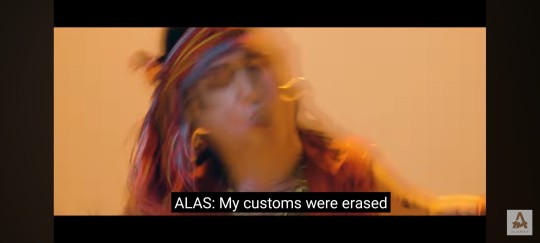
3. Erasure of indigenous practices and traditions in lieu of Christianity.
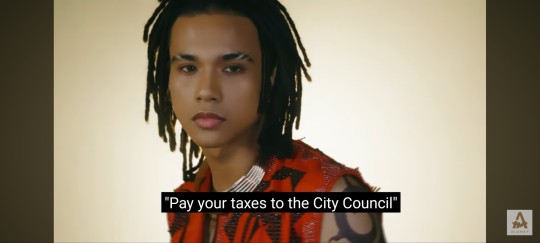
4. The lyrics references to the cedula or the taxes Filipinos were made to pay.

5. Spanish colonizers imposed the use of Spanish -based family names through the Catálogo alfabético de apellidos.

7. The Spanish conquistadores under the command of Portuguese Fernando Magellan went on a conquest to find Moluccas or the Spice Islands, in the guise of trade. All the while, they have also been on the ready for conquest.

8. Most indigenous peoples of the Philippines would get the honor of getting tattoos for their courage and bravery in battle. Every tattoo pattern or design would mean a significant symbolism.
9. Tomas in a stylized Katipunero hat
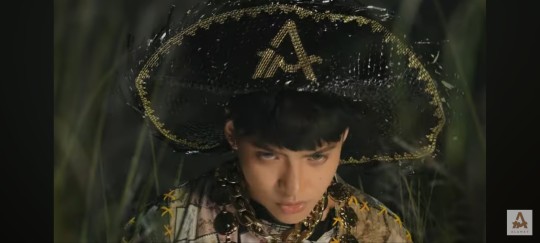

10. RJi and Jao representing the 19th century Filipinos. In this period, the Philippines has become a colony of Spain for 333 years.
They haven't released a BTS or the making of the MV vlog at the moment, but this particular track is on the OST of a movie to be released on December called Penduko. All those mentioned above are from what I've learned from my HS and/or college education. It has been alamat's mission to serve edutainment.
Please reblog and add if I missed some! Thank you so much!
#ppop rise#opm#alamat#alamat mo#ppop#alamat taneo#alamat alas#alamat jao#alamat tomas#alamat rji#alamat dagundong#philippine culture#philippines#alamat magiliw#6inoo
49 notes
·
View notes
Text
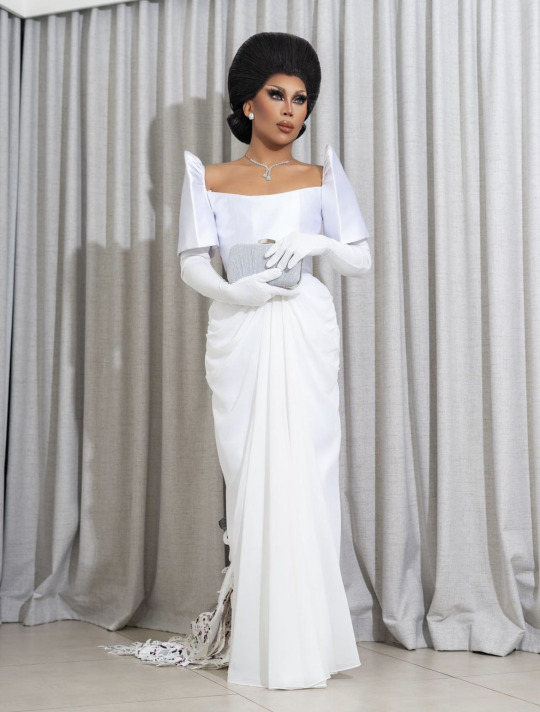
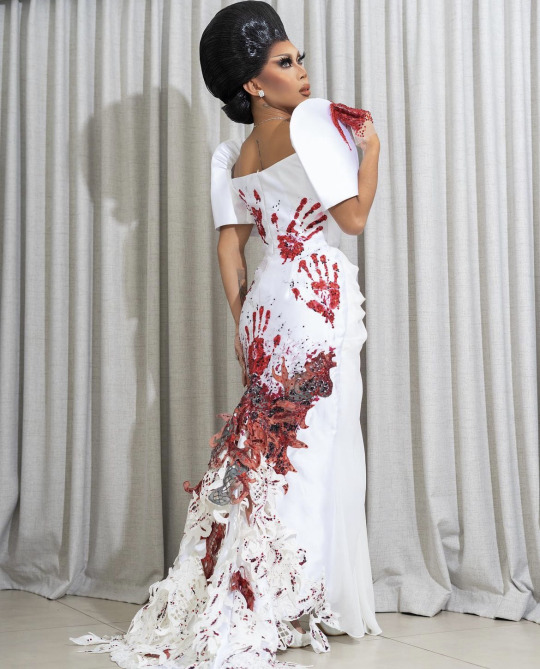
Marina Summers for Unkabogaball 2022
#philippines#inspiration#fashionph#philippine culture#pinoypride#fashion#styleph#filipino#filipino fashion#filipino history#ph#philippine history#manila#drag queen#neverforget#martial law#marcos#philippine fashion
245 notes
·
View notes
Text
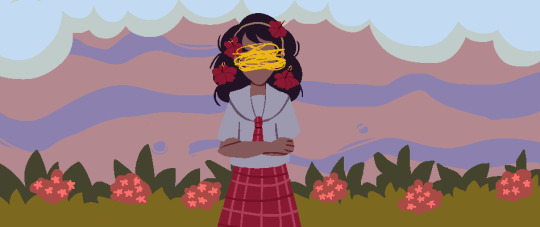
SWELLBLOOM KIDS is a ttrpg built around Filipino beliefs and folklore. Here, you play as the eponymous swellbloom kids, whose moods rise and fall due to cosmic El Niño and La Niña, respectively. Sensitive to the movements of the universe, they are gifted supernatural abilities thanks to The Twelve Guardians, deities watching over the different parts of the year and forming a zodiac of sorts.
Swellbloom Kids features reimagined mythical figures, from the moon-eating snake Bakunawa (here, a primordial force of chaos seeking to swallow reality) to the personified cold La Niña (here, a rain goddess that warps time).
This ttrpg also contains plot hooks, so you can play within the various eras of Philippine history. Some examples are:
These Snake-Eyed Children- rebuild a local community during the age of epic heroes.
Love in the Time of Conquista - save the romance between the conquistador Juan de Salcedo and the princess Kandarapa during the founding of Spanish Manila.
Guardia de Honor - investigate a mysterious cult of bandits during the Philippine-American War.
When the Paddylarks Weep - unravel a family curse and the murders that come with it in 1950s Mindoro.
Swellbloom Kids is also a love letter to being neurodivergent - it's a game about being bipolar, written by a bipolar person. Hope you can check it out.
#swellbloom kids#ttprg#tabletop rpg#philippine history#philippine mythology#philippine folklore#philippine culture
31 notes
·
View notes
Text
Short Gossip!
So today, April 25th is the festival of our hometown, The Bahaghari festival, in English, Rainbow festival. There's a history on that.
Anyways, 6 schools compete in a street dance competition, also my school and guess what? WE GOT IN 2ND PLACE! It was the first time that our school had competed and was introduced in our town, the fact that we're the smallest school among the other competitors. My cousin was a part of the dance and he was a good dancer, the fact he's on the front (proud cousin moment). Plus, our props and costumes are colorful and bright.
Also a couple of dancers from other schools fainted because of the heat of this country, I think it's about 37°c, even my phone got hot while filming the dance.
Plus their props and costumes were overboard which makes it hotter, also I heard they never slept while practicing at the previous days b4 the festival, day and night. I hope they're doing ok - :3
5 notes
·
View notes
Text
According to my dad, in order to be a Filipino, we must eat balut /j.
…OH MAN, THAT CHICK–
3 notes
·
View notes
Text

Tala goddess, 2021, oil on canvas, by Nat Lamina.
#philippines#philippine mythology#philippine history#mythology and folklore#philippine art#classical art#painting#goddess#philippine culture#pinoy#pinoy art#filipino#prehispanic
45 notes
·
View notes
Text
Talking about one's self [Part 2]
In this series of posts, I'll be posting about some declarative statements that can be used when talking about one's self in a conversations or during self-introductions.
2) Expressing Likes and Desires
Expressing something that you already like as a declarative sentence and expressing something that you like or want to do as an intention (not yet done) is often expressed as "gusto" in Tagalog. It can both mean like and want.
Gusto ko / ko(ng)
Usually followed by a pronoun or an action word, to express desire to do something or express fondness/liking for a certain hobby. If the action word is in contemplative aspect, then it might be expressing desire to do something. If the action word is in imperfect aspect that implies it is regularly being done, then it might be expressing fondness or liking for a hobby or an activity.
Examples:
Hanga ako sa pamumuno ni Lea. Gusto ko siya maging kaibigan. (Trans: I admire Lea's leadership. I want her to be my friend.)
"siya" is a pronoun referring to Lea
Gusto kong kumain ng Jollibee Chickenjoy. (Trans: I want to eat Jollibee Chickenjoy.)
Gusto kong makita mag-perform nang live ang Blackpink. (Literal: I want to see Blackpink perform live.)
Both the action words "kumain" (to eat) and "makita" (to see/watch) are in contemplative aspect, therefore the speakers express desire to do those activities.
Gusto kong namamasyal sa probinsya tuwing bakasyon. (Trans: I like visiting and going around the province every time I stay for a vacation.)
The action word "namamasyal" (to visit and stroll -- visiting and strolling) is in imperfect aspect, meaning that it is still being done, in the process of being completed, or is regularly happening ("tuwing" (every time...)). When translated to english, it becomes a noun in function.
Gusto kong maging...
This phrase literally means, "I want to become..." and it can be followed by a noun with or without a modifier.
Examples:
Gusto kong maging matagumpay na negosyante. (Trans: I want to become a successful entrepreneur.)
"negosyante" means entrepreneur, which is a noun and modified by the adjective "matagumpay" which means successful
Gusto kong maging oncologist, 'pag nakatapos na ko ng pag-aaral. (Literal: I want to become an oncologist when I finish my studies.)
oncologist is a noun that is specific to people
Gusto kong magkaroon ng...
This is the combination of has/have and expressing like statements. It translates to "I want to have..."
Examples:
Gusto kong magkaroon ng bag na Chanel. (Trans: I want to have a Chanel bag.)
Gusto kong magkaroon ng maraming pera! (Trans: I want to have lots of money!)
Note: In actual conversations, sometimes "magkaroon" is dropped and simply use the "Gusto kong..." or "Gusto ko ng..." since both phrases expresses for things or events that are still yet to happen or will happen in the future, which is also being implied in "Gusto kong magkaroon..." sentences. Example: both sentences above can also be stated as "Gusto ko ng bag na Chanel," and "Gusto ko ng maraming pera!" Although the desire to possess both things are not explicitly stated, the speaker's meaning is left to be interpreted based on the context of conversation.
Gusto ko si ____ / ng ____
Usually followed by nouns. "Si" is followed by proper pronouns especially if a name of a person, while "ng" is usually followed by common or abstract nouns.
Examples:
Gusto ko si Ben dahil hindi siya nagsasabi ng mga birong sexist. (Literal: I like Ben because he doesn't tell sexist jokes.)
"Ben" is a name of a person. "Si" becomes a marker for a proper noun.
Gusto ko ng sariling bahay para magkaroon na ko ng privacy. (Literal: I want my own house for me to have privacy.)
"Bahay" is a common noun or object meaning house, while the word "sarili" is a modifer that means my own or mine.
Additional notes:
Most of the ko pronouns used can be substituted by other pronouns like mo, ninyo, niya, nila, natin, and namin.
Pay attention to how si and ng are used to be familiarized with these
#learn tagalog#tagalog langblr#filipino langblr#learn filipino#philippine culture#pinoy culture#authors#language study#filipino grammar#tagalog grammar#tagalog native speaker#how to speak tagalog
10 notes
·
View notes
Text
ttrpg classes based on filipino products and culture.
MANGO CLERIC: You grew up in a monastery surrounded by mango orchards. Fruitsong and honeywisdom - you harness the mangos’ metaphysical sweetness to heal your allies.
COFFEE BARBARIAN: You stopped eating solid food a while back. Coffee flows through your veins. You’re always this close to going on a rampage.
SUGAR WARLOCK: You entered a contract with the god of your family’s sugar plantation. Giving up your life of ostentation, you’ve dedicated yourself to protecting the oppressed.
TUNA ROGUE: You’re as slippery as the fish port you worked in. Weaving in and out of places, just like the tuna you smuggle.
BEATA PALADIN: Mercy and miracles go hand in hand. You swore an oath of poverty to the Almighty, giving you the power of the santos.
BAKYA FIGHTER: You grew up on the streets. Those who underestimate your slippers won’t know what hit them.
COCONUT DRUID: Coconuts are as old as creation itself. You harness their energy as the Trees of Life - “sky above and below, with water in between” as the riddle goes.
BANDURRIA BARD: A bottle of tuba and a string instrument are all you need. You croon the old melodies, of loves lost and torn asunder. Heartbreak flows through your singing.
SQUID WIZARD: The squid-ink scribblings of old are long gone - or so the conquistadores thought. The inkbearers remember, and have passed their knowledge to you.
13 notes
·
View notes
Text
The First Blade: Balaraw - Winged Dagger
I realize I haven't been explicit about it on here yet (mostly because I'm not the best at keeping all my social media profiles up to date), but I am involved in the development of a Tabletop Roleplaying Game
It's called Gubat Banwa- a TTRPG based around tactical grid combat, contemplative war drama, and high-flying martial arts, all of which taking place in an unapologetically Southeast Asian-inspired fantasy setting, developed by @makapatag with art direction by @villain-returns.
Initially I developed the script that is used in the gamebook and diegetically in the setting- called Kasuratan- but I'll talk about that elsewhere.
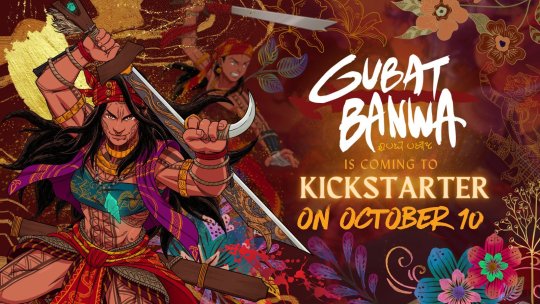
With the Kickstarter launch imminent, I thought I'd do a bunch of Twitter X threads on a bunch of weapons I've drawn for the game counting down the final week before the launch. Then I thought: "Why aren't I posting these on tumblr also, at least I wouldn't lose my mind over character counts over here"- so here we are. These were supposed to be posted as Swordtember drawings, but then the KS launch got moved to October.
Most of these blades are of Philippine make, since that is where my knowledge-base is and what I'm comfortable enough to share knowledge about. I thought it'd be nice to share a bit of blade knowledge from some of the cultures that inspired the setting.
Without further ado, let us begin with the BALARAW.
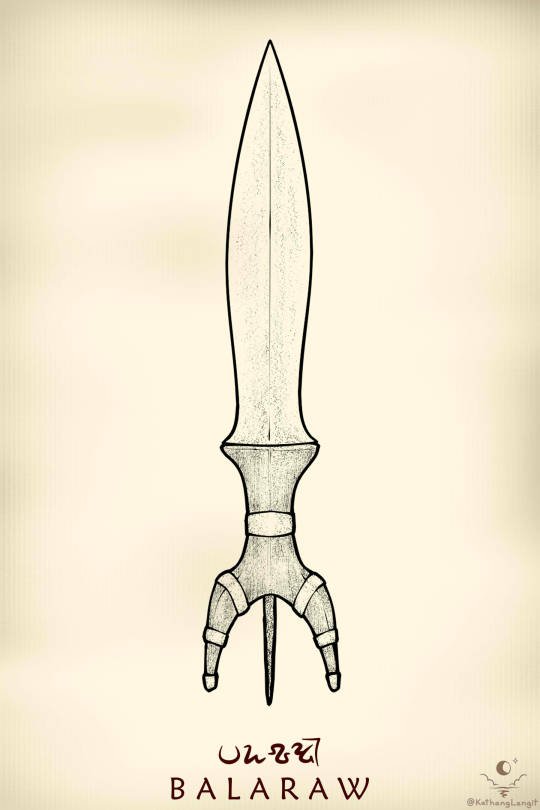
Also known as a "winged dagger", it is characterized by its unique shape, consisting of a short leaf-shaped blade driven with the tang out into a hilt with two distinct protrusions, creating three prongs on the back with the tang included.

(Photos from an exhibit at The Met)
They may be held at the hilt like a regular knife, or they may be held in a manner not too dissimilar from how our neighbors in Southeast Asia hold keris. One may imagine it like a "push dagger" for lack of other reference points. It might be likened to the katar as well, in some sense.


(Sketches by the Gubat Banwa Art Director himself)
Nowadays, the blade is frequently attributed to the People of the Upstream- the Mandaya group of peoples- though they would have seen much wider use in their day, likely also spanning across what is now the Visayas region of the Philippines.

(Modern rendition by Panday Keiven Tolentino of Itak Mindoro, Photo by Ramon H. Bathan)
Something I've noticed from looking at Philippine blades all the time is that symmetrical, double-edged blades like these are rare, here. Blades that lend themselves more to stabbing than anything else aren't very prevalent either, and blades that do not- at first glance- appear to be made with tool use/foliage clearing/farmwork in mind don't make up the majority of specimens.
The balaraw is unique in several different respects, and any self-respecting warrior Kadungganan of Gubat Banwa's Sword Isles would do well to mind its bite.
The weapon makes an appearance in Gubat Banwa in the hands of the Beast Hunter- one of the many Disciplines ("character classes") whose techniques your character can learn in-game.
The Gubat Banwa Kickstarter launches in 7 days! Check it out here:
We'd appreciate any and all help in getting the word out. Support an independent TTRPG made by a team from the global south, looking to make waves through a fantasy setting where the Southeast Asian inspirations takes center stage!
#gubat banwa#gamedev#ttrpg#ttrpgs#indie ttrpg#indie ttrpgs#tabletop rpgs#rpgs#rpg#southeast asia#southeastasia#dnd#kickstarter#swords#philippine blade#weapon design#dagger#balaraw#philippine history#philippine culture#filipino artists#artists on tumblr#kathang langit#help us get the word out!#fantasy#fantasy worldbuilding#swordtember
113 notes
·
View notes
Text


Mga katutubong pangalan ng mga tala ni Orion at ng konstelasyong Pleiades, mula sa BALATIK: Katutubong Bituin ng mga Pilipino ni Dante L. Ambrosio
available here
#the philippines#pilipinas#philippine history#philippine culture#philippine literature#dante l ambrosio#ethnoastronomy#astronomy#my curations
41 notes
·
View notes
Text
Re blog if you’re a religiously traumatised Filipino I’m trying to see something
#filipino#philippines#philippine culture#filipino culture#filipino american#pinoy#religion#christianity#catholic#Christian#Catholicism#ex catholic#ex christian#religious trauma
107 notes
·
View notes
Text
Things I saw on pinterest today



#true bestie#and it's not even a proverb#it's just an expression#want a cliche filipino proverb?#ang wala tyaga walang NILAGA!!!!#reblog if when you feel powerless and helpless you say 'bahala na si batman'#i say this when I have exam in 5 minutes and I didn't review anything#philippines#filipino#philippine culture#art
50 notes
·
View notes

